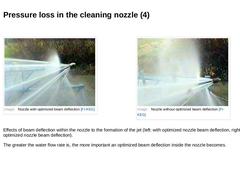
|
(Image: Nozzle with optimized beam deflection) (Image: Nozzle without optimized beam deflection) Effects of beam deflection within the nozzle to the formation of the jet (left: with optimized nozzle beam deflection, right: without optimized nozzle beam deflection). The greater the water flow rate is, the more important an optimized beam deflection inside the nozzle becomes. |
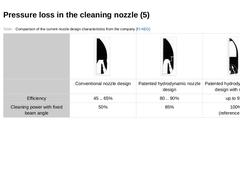
|
(Table: Comparison of the current nozzle design characteristics from the company KEG) |
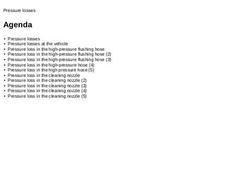
|
|
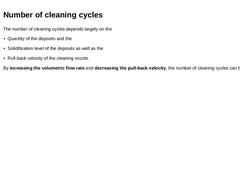
|
The number of cleaning cycles depends largely on the -
Quantity of the deposits and the
-
Solidification level of the deposits as well as the
-
Pull-back velocity of the cleaning nozzle.
By increasing the volumetric flow rate and decreasing the pull-back velocity, the number of cleaning cycles can be reduced. |
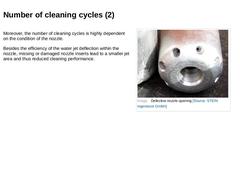
|
Moreover, the number of cleaning cycles is highly dependent on the condition of the nozzle. Besides the efficiency of the water jet deflection within the nozzle, missing or damaged nozzle inserts lead to a smaller jet area and thus reduced cleaning performance. (Image: Defective nozzle opening) |
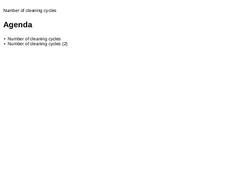
|
|
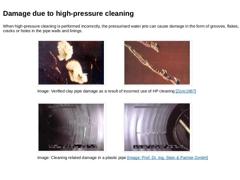
|
When high-pressure cleaning is performed incorrectly, the pressurised water jets can cause damage in the form of grooves, flakes, cracks or holes in the pipe walls and linings. |
(Image: Verified clay pipe damage as a result of incorrect use of HP cleaning) |
(Image: Verified clay pipe damage as a result of the incorrect use of HP cleaning) |
|
Image: Verified clay pipe damage as a result of incorrect use of HP cleaning [Züric1987] |
|
|
|
(Image: HP cleaning … |
|
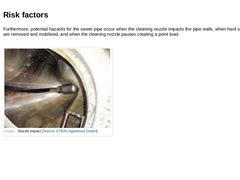
|
Furthermore, potential hazards for the sewer pipe occur when the cleaning nozzle impacts the pipe walls, when hard solid deposits are removed and mobilised, and when the cleaning nozzle pauses creating a point load. (Image: Nozzle impact) |
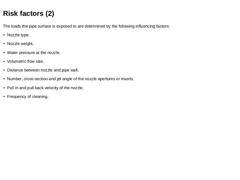
|
The loads the pipe surface is exposed to are determined by the following influencing factors: -
Nozzle type,
-
Nozzle weight,
-
Water pressure at the nozzle,
-
Volumetric flow rate,
-
Distance between nozzle and pipe wall,
-
Number, cross-section and jet angle of the nozzle apertures or inserts,
-
Pull in and pull back velocity of the nozzle,
-
Frequency of cleaning.
|
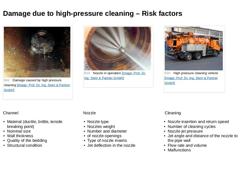
|
(Image: Damage caused by high pressure cleaning) (Image: Nozzle in operation) (Image: High pressure cleaning vehicle) Channel -
Material (ductile, brittle, tensile breaking point)
-
Nominal size
-
Wall thickness
-
Quality of the bedding
-
Structural condition
Nozzle -
Nozzle type
-
Nozzles weight
-
Number and diameter
-
of nozzle openings
-
Type of nozzle inserts
-
Jet deflection in the nozzle
Cleaning -
Nozzle insertion and return speed
-
Number of cleaning cycles…
|
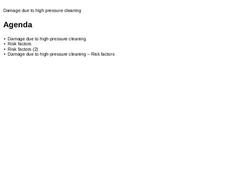
|
|
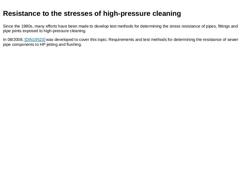
|
Since the 1980s, many efforts have been made to develop test methods for determining the stress resistance of pipes, fittings and pipe joints exposed to high-pressure cleaning. In 08/2008, [DIN19523] was developed to cover this topic: Requirements and test methods for determining the resistance of sewer pipe components to HP jetting and flushing. |
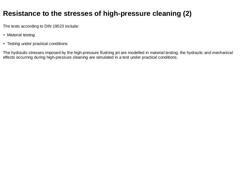
|
The tests according to DIN 19523 include: The hydraulic stresses imposed by the high-pressure flushing jet are modelled in material testing; the hydraulic and mechanical effects occurring during high-pressure cleaning are simulated in a test under practical conditions. |
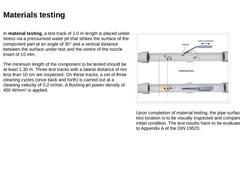
|
In material testing, a test track of 1.0 m length is placed under stress via a pressurised water jet that strikes the surface of the component part at an angle of 30° and a vertical distance between the surface under test and the centre of the nozzle insert of 10 mm. The minimum length of the component to be tested should be at least 1.30 m. Three test tracks with a lateral distance of not less than 10 cm are inspected. On these tracks, a set of three … |
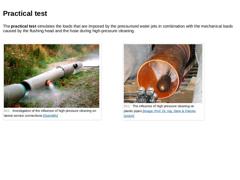
|
The practical test simulates the loads that are imposed by the pressurised water jets in combination with the mechanical loads caused by the flushing head and the hose during high-pressure cleaning. (Image: Investigation of the influence of high pressure cleaning on lateral service connections) (Image: The influence of high pressure cleaning on plastic pipes) |
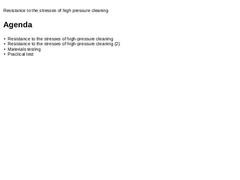
|
|
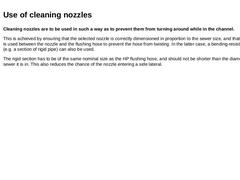
|
Cleaning nozzles are to be used in such a way as to prevent them from turning around while in the channel. This is achieved by ensuring that the selected nozzle is correctly dimensioned in proportion to the sewer size, and that a swivel joint is used between the nozzle and the flushing hose to prevent the hose from twisting. In the latter case, a bending-resistant extension (e.g. a section of rigid pipe) can also be used. The rigid section has to … |
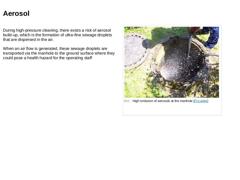
|
During high-pressure cleaning, there exists a risk of aerosol build-up, which is the formation of ultra-fine sewage droplets that are dispersed in the air. When an air flow is generated, these sewage droplets are transported via the manhole to the ground surface where they could pose a health hazard for the operating staff (Image: High emission of aerosols at the manhole) |
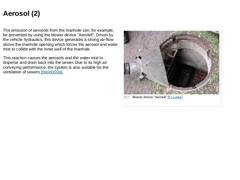
|
The emission of aerosols from the manhole can, for example, be prevented by using the blower device "Aerokill". Driven by the vehicle hydraulics, this device generates a strong air-flow above the manhole opening which forces the aerosol and water mist to collide with the inner wall of the manhole. This reaction causes the aerosols and the water mist to disperse and drain back into the sewer. Due to its high air conveying performance, the system is … |
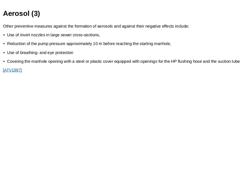
|
Other preventive measures against the formation of aerosols and against their negative effects include: -
Use of invert nozzles in large sewer cross-sections,
-
Reduction of the pump pressure approximately 10 m before reaching the starting manhole,
-
Use of breathing- and eye protection
-
Covering the manhole opening with a steel or plastic cover equipped with openings for the HP flushing hose and the suction tube.
[ATV1997] |

|
|
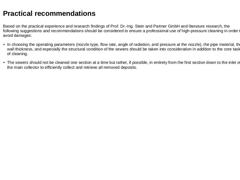
|
Based on the practical experience and research findings of Prof. Dr.-Ing. Stein and Partner GmbH and literature research, the following suggestions and recommendations should be considered to ensure a professional use of high-pressure cleaning in order to avoid damages: -
In choosing the operating parameters (nozzle type, flow rate, angle of radiation, and pressure at the nozzle), the pipe material, the wall thickness, and especially the structural …
|
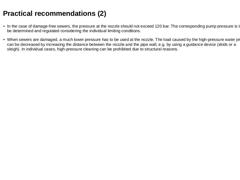
|
-
In the case of damage-free sewers, the pressure at the nozzle should not exceed 120 bar. The corresponding pump pressure is to be determined and regulated considering the individual limiting conditions.
-
When sewers are damaged, a much lower pressure has to be used at the nozzle. The load caused by the high-pressure water jets can be decreased by increasing the distance between the nozzle and the pipe wall, e.g. by using a guidance device (skids …
|
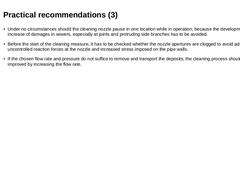
|
-
Under no circumstances should the cleaning nozzle pause in one location while in operation, because the development or increase of damages in sewers, especially at joints and protruding side branches has to be avoided.
-
Before the start of the cleaning measure, it has to be checked whether the nozzle apertures are clogged to avoid additional and uncontrolled reaction forces at the nozzle and increased stress imposed on the pipe walls.
-
If the chosen …
|
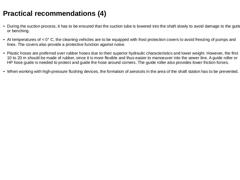
|
-
During the suction process, it has to be ensured that the suction tube is lowered into the shaft slowly to avoid damage to the gutter or benching.
-
At temperatures of < 0° C, the cleaning vehicles are to be equipped with frost protection covers to avoid freezing of pumps and lines. The covers also provide a protective function against noise.
-
Plastic hoses are preferred over rubber hoses due to their superior hydraulic characteristics and lower …
|